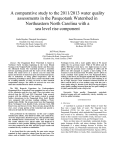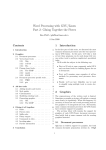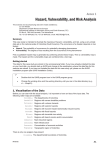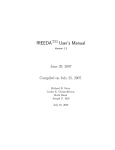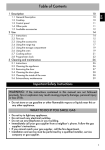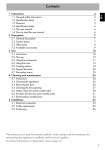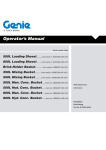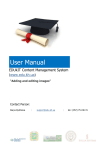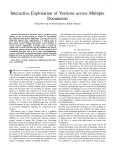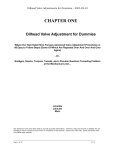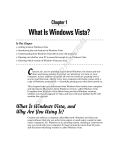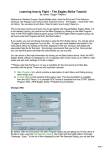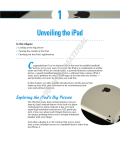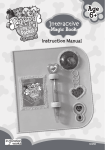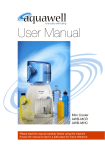Download Salt & Fire
Transcript
Himalayan Salt Blocks Salt on Food READ BEFORE USING salt - chocolate - wine - flowers 2 salt – chocolate – wine – flowers “Salt is born of the purest of parents: the sun and the sea.” — Pythagoras (580 BC - 500 BC) “Where would we be without salt?” — James Beard (1903 - 1985) “When I write of hunger, I am really writing about love and the hunger for it, and warmth and the love of it and it is all one,” — MFK Fischer (1908 - 1992) 3731 N. Mississippi Ave. – Portland, OR 97227 www.atthemeadow.com – 888-388-4633 – 646-218-4618 fax Copyright © 2007 by The Meadow. 3 salt – chocolate – wine – flowers Himalayan Pink Salt A boulder of Himalayan rock salt emerges from darkness of a 16th century mineshaft in Pakistan and explodes into light, catching and refracting the sun in hues ranging springwater clear to hibiscus pink to venison red. Stonemasons in a neighboring town then hand cut the great rock into a variety of shapes, providing the foundation for extraordinary new ways to prepare and serve food. The Meadow’s Himalayan salt blocks, plates, bricks, and platters can be used for sautéing, grilling, chilling, curing, baking, presenting, salting, bathing, building, and contemplating. There are as many uses for The Meadow’s heavy slabs of Himalayan Pink Salt blocks as there are foods, cooking styles, whims, acts of folly, and shows of bravado. Serve moist food on it, such as mozzarella and sliced apples, and the food will pick up a delicate saltiness that sets it off perfectly. Heat a salt plate on the stove, then set the hot block on a trivet at the table to sear scallops or thinly sliced hanger steak while seated with your guests. Quick Start Guide: Cooking with Himalayan Salt Blocks Himalayan Pink Salt Blocks can be heated, cooled, or left at room temperature. Cold room and temperature uses require no special instruction; simply plate food on the salt block and serve. Heating Himalayan Salt Blocks requires following some basic steps. (Please see the important disclaimer at the back of this guide.) Allow between 30 to 45 minutes to achieve the desired cooking temperature. Also, note that heating will change the appearance of your Himalayan Salt Block. Your salt plate will crackle slightly on heating as micro-fissures appear, clouding the clear finish of the salt block. This is normal, but you may wish to keep one piece for heating and reserve another for room temperature uses. 1. 2. 3. 4. Verify that the size and composition of your salt block is suitable for heating by consulting with The Meadow staff (toll free 888-388-4633 or [email protected]). Be sure the salt block is completely dry. If wet, allow to dry at least 24 hours in a warm, dry place before heating. For gas ranges, place your Himalayan Salt Block on the burner over low flame. After 15 minutes (allow more time for plates larger than 8" x 8" x 1.5"), increase heat to low-medium. After 15 minutes, your salt plate will be hot enough to cook on. If extremely hot temperatures are desired, as for searing duck foie gras, increase flame to medium-high for another 15 minutes. For electric ranges, place a metal spacer—such as wok ring or pastry tin with a removable bottom—on the stove so that the Himalayan Salt Block is at least 1/2 inch above the heating element. It is important that the salt not touch the 3731 N. Mississippi Ave. – Portland, OR 97227 www.atthemeadow.com – 888-388-4633 – 646-218-4618 fax Copyright © 2007 by The Meadow. 4 salt – chocolate – wine – flowers heating element, as direct contact could damage your range or your salt, or both. With the salt block in place, follow instructions 3a above, allowing as much a 5 minutes more for each step. We use a portable electric hotplate for special events and have great success with it. Recipe & Cooking Ideas Here are just a few basic uses for Himalayan Salt Blocks. a) Arrange thinly sliced Carpaccio or sashimi on a cool salt platter and serve. Watch as the food literally salt-cures while at the table, gently cooking the edges and bringing on just a smidge of mineral-rich saltiness. b) Set your 8” x 8” salt plate on a gas range (or use a wok-ring on an electric range), heat until scorching hot, and fry an egg! This salts to perfection, or put butter on the surface for less. The magic is that the bottom of the egg gets salted, delivering delicate saltiness directly to your tongue, accentuating the delicate flavors of the egg. c) For an out-doorsy variation on the above, place a large Himalayan Salt Platter on the grill, and sear a fennel-and-lemon stuffed monkfish (actually, any whole fish will do, but one must seize the opportunity to say “monkfish” whenever possible), or a limeand-ginger marinated flank steak, or a balsamic and garlic rubbed Portobello mushroom. Important: the prolonged contact with moisture that occurs with any longer-cooking recipes dissolves more of the salt block’s surface, causing irregularities or pitting. While this may reduce the usable lifetime of a Himalayan Salt Block, multiple uses should still be possible. d) Freeze a Himalayan salt plate for two hours. Scoop cream or sorbet atop. e) More fun yet, freeze a Himalayan salt plate for two hours. Then, over medium heat, warm lightly whipped sweet heavy cream, egg, honey, and aged bitters, and refrigerate. Remove the salt slab from freezer, pour mixture on it, slowly lufting with spatula, for a salt-tinged ice custard you will not soon forget. f) Impress your Jewish grandma with Gravlax. Thaw a filet of commercially frozen (for health reasons) salmon, roll in sugar and minced dill, arrange on a Himalayan Pink Salt plate (4" x 8" x 1/4" or 4" x 8" x 2", for example), cover with a heavy brick (4" x 8" x 2") of Himalayan salt, wrap in paper bag and refrigerate for three days. Slice, serve with crème fraîche, capers, and melba toast—or just eat plain. g) Getting back to basics, use it as a serving platter for cheeses, dried meats, or your daily dose of pickled ginger and wasabi. When used as a plate for moist food such as apple slices and mozzarella, the food acquires an enhanced salt and mineral flavoring. h) Rid yourself forever of unbutter butter forever! Why let a mass-manufacturer you have never met choose the quality and quantity your salt? Instead, buy unsalted sweet cream butter and keep it on a beautiful 4" x 8" x 1/4" Himalayan Salt plate as a 3731 N. Mississippi Ave. – Portland, OR 97227 www.atthemeadow.com – 888-388-4633 – 646-218-4618 fax Copyright © 2007 by The Meadow. 5 salt – chocolate – wine – flowers butter dish. The butter does not have enough moisture to pick up much saltiness, but the glowing pink salt block will remind you to salt your buttered food to taste. Also, if you like to refrigerate your butter—as can be necessary in hot weather—the salt block will keep the butter chilled long after it has been taken back out of the fridge for use. i) If musty corners of your soul crave drama, try serving up an entire meal using large round or square Himalayan salt plates. Moist foods take on a touch of saltiness, dry foods do not, and everything glows with the otherworldly power of the ancient world (see Ogling below). j) Cut your prettiest Himalayan Salt plate into jewelry, set in the precious metal of your choice, and nibble it as nibble jewelry from the lobes and fingers of your loved-one. k) Take a bath (with or without the jewelry), breaking up an old salt plate and tossing it into the tub. Himalayan Pink salt blocks contain 84 trace minerals and serve as a soothing and therapeutic bath salt, and rough bits work as a pumice stone. Caring for your Pakistani Pink Himalayan Salt Plate After each use, rinse your salt plate with warm water, scrub with a soft brush or green scouring pad to remove any stuck matter, and rinse again. Tamp dry with a paper towel or clean cloth. Set on a drying rack. This will process removes a very thin layer of the salt. Treated with care, a large salt block can provide dozens of uses. The powerful antimicrobial properties of the salt insure that it is always proper and ready for future use, with no need for detergents. Additional care and use information, as well as cooking ideas, are available at www.saltnews.org The crystal lattice of our Himalayan Pink Salt Blocks has a high specific energy (energy per unit of mass), so they hold any temperature you bring it to for a good while. Likewise, this makes for excellent heat distribution, making grandma’s heavy old cast iron skillet seem like tinfoil by comparison. Because Himalayan Salt Blocks generally have an extremely low amount of porosity, and virtually no residual moisture (.026%), the salt plates can be safely heated or chilled to great extremes. We have tested them from 0°F up to 700°F (-18°C to 370°C). Salt melts at 1473.4°F (800.8°C). Two other considerations come into play when working with our Himalayan salt plates. Their lack of porosity means that the surface area touching your food is minimal, so these large blocks of salt will impart only a very moderate saltiness. Second, the high quantity of trace minerals (1.2% sulfur, .4% calcium, .35% potassium, .16% magnesium, and 80 other trace minerals) impart a more mild and full taste to the salt, and by extension, more flavor complexity to your food. 3731 N. Mississippi Ave. – Portland, OR 97227 www.atthemeadow.com – 888-388-4633 – 646-218-4618 fax Copyright © 2007 by The Meadow. 6 salt – chocolate – wine – flowers Ogling Your Himalayan Pink Salt Plate Let your mind drift overland, off the path, and into the wilds of the Hindu Kush, where wildflowers scatter under the tessellated fingerprint of a mild spring breeze. We take up with the torrents of the Amu Darya river, and just keep climbing, along the ancient path where recorded history began, back in the 6th century BC, under the Achaemenid Empire. Weeks later, in the rarified air of northern Punjab’s Himalaya mountain range, we find a quarry where men pull massive boulders of luminescent pink ore from the earth, glowing like freshly harvested meteorites. Gaze into the deep ferrite light of a massive block of Himalayan salt, and glimpse the unfathomed history of our planet. Pakistani pink Himalayan salt was formed in the Precambrian era, about 600 million years ago, as a great inland sea evaporated. The salt is rich in iron, calcium, and 82 other trace minerals—in a remarkably similar balance as that of the human body. Volcanic and other geological activity then sealed the salt in a hermetic vault where, over eons, it was subjected to the intense pressure and heat of the deep earth. Over countless ages the land rose to become the Himalayas. Meanwhile, the scattering of Eukaryotic cells that comprised all life on earth evolved into shellfish and trilobites. Fish began to swim in the sea, great fern forests emerged, and then came the reptiles. Still the salt glowed darkly in the depths of the earth. Dinosaurs grew to towering heights, mammals peeked from beneath the leaves, and birds took flight. Grazing and carnivorous mammals, and then primates took hold, and still the salt remained in darkness. Man appeared, gawking at the heavens and whittling spears, then scattering across Asia and beyond. 1.8 million years later, one lovely evening in 326 BC, Alexander the Great gave his troops a rest in the Khewra area of what is now Pakistan. An observant fellow noted in his diary that the horses were taken with licking the rocks—and lo, salt was discovered. Some eighteen centuries later, Jalaluddin Muhammad Akbar was born. At the age of thirteen, the boy’s father fell to his death from the library stairs, and Akbar ascended to rule, eventually becoming the Mughal empires greatest ruler. Akbar’s two lasting contributions were the vast accessioning of art from around the world into the Mughal collections, and the introduction of standardized salt mining at Khewra. Our Himalayan Salt is harvested in the same way it was under Akbar. The choice boulders from the harvest—sometimes weighing in excess of 500 pounds—are sliced into cubes and platters and planks and chunks for use on your table. Mark Bitterman Selmelier The Meadow Visit www.saltnews.org for news and ongoing conversation on artisan salts. 3731 N. Mississippi Ave. – Portland, OR 97227 www.atthemeadow.com – 888-388-4633 – 646-218-4618 fax Copyright © 2007 by The Meadow. 7 salt – chocolate – wine – flowers Disclaimer If you wish to cook on your salt block, please understand that you assume all responsibility. The Meadow or its staff is not responsible for damages, injury, or loss due to the use of our Himalayan Salt products. This includes any that may result from the heating of Himalayan Salt blocks or similar products. Pakistani Pink Himalayan Salt Plate Standard Sizes Mini Plate 2" x 4" Small Amuse Bouche Cube 2" x 2" x 2" Sushi Stick 2" x 8" x .75" Rectangular Butter Plate 4" x 8" x .75" Rectangular Brick 4" x 8" x 2" Rectangular Plate 6" x 8" x 1.5" Large Round Plate 8" diameter x 1.5" Small Square Plate 5" x 5" x 1.5" Medium Square Plate 6" x 6" x 1.5" Large Square Plate 8" x 8" x 1.5" Medium Natural Top Plate 5.5" x 6.5" x 1.5" Small Platter 8" x 16" x 1.5" Large Platter 9" x 18" x 1.5" Salt plates can be custom cut to your specification upon request. 3731 N. Mississippi Ave. – Portland, OR 97227 www.atthemeadow.com – 888-388-4633 – 646-218-4618 fax Copyright © 2007 by The Meadow.







